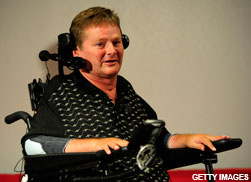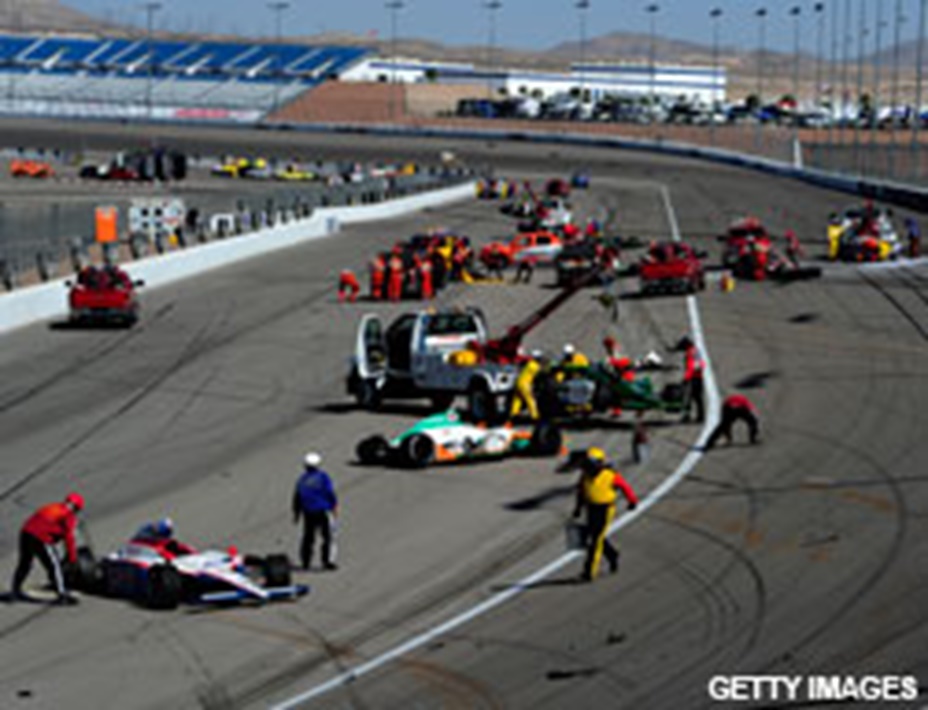Following the death of driver Dan Wheldon during Sunday’s Izod IndyCar World Championships at Las Vegas Motor Speedway, the national spotlight is on the IndyCar series “but for the wrong reasons,” according to a front-page cover story by Nate Ryan of USA TODAY. Wheldon’s death is “shocking the motor sports community and raising a range of questions among drivers, sponsors and fans about how the sport is run and its future.” But perhaps “none is more prominent” than the nation’s “fastest racing series stretching the limits of safety and putting its stars -- the drivers -- in untenable conditions.” Drivers from other circuits yesterday “shared similar sentiments.” NASCAR driver Jimmie Johnson said, “Those cars are going so fast and get airborne frequently, I wouldn’t run them on ovals.” Former F1 and CART driver Mark Blundell wrote on his Twitter feed, “I tend to agree with NASCAR driver Jimmie Johnson that indycar should focus on road and street tracks.” Ryan notes Wheldon’s crash “might accelerate the disappearance of ovals in IndyCar, which has struggled to draw crowds at the types of races that produce the most passing.” The series is “committed to return to Vegas as its season finale next year, but it might run at only one other 1.5 mile-oval -- Texas Motor Speedway -- next year.” Just Marketing Int’l Founder & CEO Zak Brown: “You have to make sure that you study and fully understand what happened. Was it too many cars? Was the track too small or too fast, or was it a case of the wrong accident at the wrong time?” Ryan notes NASCAR at tracks with high-banking ovals “requires a carburetor that restricts airflow to the engine and chokes down horsepower, keeping speeds below 200 mph.” IndyCar could “look at similar ways to reduce speeds, whether by restricting horsepower or adding ‘drag’ that increases aerodynamic resistance” (USA TODAY, 10/18).
LOOKING AT ALL OPTIONS: In Indianapolis, Anthony Schoettle noted IndyCar officials are “likely to evaluate the design of the series' cars and the tracks it races on.” Frost Motorsports President Tim Frost said, “The safety record of (the IndyCar Series) has been good, but after this, they’ll be taking a long look at everything.” Former IndyCar and F1 driver Derek Daly said, “As tragic as this accident is, IndyCar has to stick to its business plan, learn what they can from this accident, and push forward. If this accident can improve the safety and improve this sport, I think Dan Wheldon would be proud to have that be part of his legacy” (IBJ.com, 10/17). ESPN's Terry Blount said the speed cars had reached during practice and qualification at Las Vegas “was just too fast,” and while he noted IndyCar has raced at other tracks similar to LVMS, the “difference was they had so many cars in the field which they usually don’t have.” Blount said the “dilemma” for IndyCar is “they need to race at these big oval tracks to draw more attention from more fans and get more people to come." Blount: “They still need to race at these tracks, but they have got to make changes. Slow the cars down" ("SportsCenter,” ESPN, 10/17). Dallas Morning News columnist Tim Cowlishaw said IndyCar “runs the problem of having a lack of appeal, and so it goes to where the big tracks are and where it can draw fans. But should they be running on those tracks? They have to look at it. ... I don’t know if they can do much more than to look at some of these tracks they run on and see if they’re really safe enough” (“Around The Horn,” ESPN, 10/17). NASCAR driver and former IndyCar driver Max Papis wrote on his Twitter feed, “I agree with u @JimmieJohnson if indycar can't find another a way on 1.5 ovals they should not race even if we raced safely in CART days” (TWITTER.com, 10/17). SPEEDTV.com's Robin Miller reports IndyCar CEO Randy Bernard "immediately began questioning himself on whether there were too many cars or the series should have avoided places like Las Vegas Motor Speedway." CART "figured out a way to run superspeedways with big fields in the late 1990s with an aero helper known as the Handford Device." Miller: "No more running wide open: ANYWHERE. And that's still a possibility with the new cars and engines for 2012" (SPEEDTV.com, 10/18).
TOO MUCH NEED FOR SPEED? CNBC's Brian Sullivan said some people "are saying you've just got to slow them down." Sullivan: "The fans want speed, but there's only so fast you can go in a car" ("Street Signs," CNBC, 10/17). Former F1 driver Jackie Stewart: “It may be that we have to have smaller engines with smaller horsepower and slower speeds in IndyCar racing. Do we have to do 230, 240mph? If all the cars were travelling at the same speeds, if you could knock off 30 or 40mph from that speed, frankly no one would notice” (London DAILY MAIL, 10/18). NBC’s Matt Lauer said, "We love speed, we love risk. But when technology allows guys to go around a track at 225-milers-per-hour on a crowded track, is it too much?” Former driver Mario Andretti said speeds have "absolutely not” gotten too fast. Andretti: "In fact, the speeds were higher back in the ‘90s when I was still racing. Some of the problem is that the cars are actually underpowered and they’re all the same. … They can’t get away from each other” (“Today,” NBC, 10/18).
WAKE UP CALL: In Charlotte, Scott Fowler writes Wheldon’s death “needs to serve as a wakeup call to that racing series -- its own sad version of an ‘Earnhardt moment.’" NASCAR driver Dale Earnhardt's death in '01 “inspired numerous and effective safety upgrades in stock-car racing, and Wheldon's must do the same in the struggling sport of open-wheel racing.” Former SMI President & CEO Humpy Wheeler said, "IndyCars absolutely must become bigger, slower and safer" (CHARLOTTE OBSERVER, 10/18). The Dallas Morning News' Cowlishaw said when Earnhardt died in ’01, it "took something like that to really move that sport forward in terms of safety” ("Around The Horn," ESPN, 10/17). In London, Kevin Eason writes the IndyCar series “now faces its ‘Senna moment’ and the biggest inquest in its long and illustrious history” (LONDON TIMES, 10/18). In London, Rick Broadbent writes Bernard's “problem remains trying to sell the danger without risking safety or glamorising crashes.” The “best hope now may be that a tragedy leads to wide-reaching change, just as it did in Formula One and NASCAR after the fatal crashes” of Senna and Earnhardt (LONDON TIMES, 10/18). CBS News' Bill Whitaker noted IndyCar "had made some impressive safety improvements over the years that have reduced deaths and serious accidents” ("Evening News," CBS, 10/17). In N.Y., Jerry Garrett writes “questions remain as to what can be done to improve the margin of safety.” For now, however, officials in charge of the sport “are loath to talk about what shape those changes might take.” Bernard on Sunday after announcing Wheldon’s death said, “That is a topic for another time.” IndyCar VP/Communications & PR Amy Konrath yesterday said, “We will be in touch when we are ready to comment.” SMI and Las Vegas Motor Speedway declined to comment (N.Y. TIMES, 10/18). After Wheldon’s death was announced, driver Dario Franchitti was asked about safety concerns. Franchitti: “We’ll discuss it and we’ll sort it out, but now’s not the time” (L.A. TIMES, 10/18).
IS BIGGEST BETTER? The WALL STREET JOURNAL’s Berzon & Bachman report Bernard “tried to make Indy racing more exciting, like its more popular cousin, NASCAR.” Bernard in June said the change to restarts would mean more "carnage and wrecks," adding the "danger will be an important element of the sport." But yesterday in an e-mail he said, "I'm sorry if my comments are interpreted this way. Danger has been an inherent part of the sport since 1909. I don't know if what I said was taken out of context or I misspoke, but if you know me, you know where my loyalties lie, and I'm very respectful to the drivers and the sport." Berzon & Bachman noted prior to his role with IndyCar, Bernard “had developed a reputation as a marketing whiz who turned the once-obscure sport of bull-riding into a nationally televised phenomenon,” and he “was recruited with a similar mandate to the Indy circuit.” Some of Bernard's efforts “appeared to be paying off,” as IndyCar races on Versus this year “drew the most viewers since the cable channel started airing races in 2009.” For many longtime drivers as sponsors, the Las Vegas race "was to be the culmination of many of those efforts.” Trade investment promotion agency Apex-Brasil USA Operations Manager & COO Silvia Pierson, whose company sponsors IndyCar, said, "The buzz in Vegas was amazing before the race" (WALL STREET JOURNAL, 10/18). ESPN IndyCar analyst Eddie Cheever said IndyCar is “in the process of reinventing itself” with Bernard, and that has included a "lot to bring more attention to Indy cars." Cheever: "But I’m afraid that the balance has moved a little bit too far to the entertainment side, and in doing that they have overlooked some very basic issues that they have” ("Outside The Lines," ESPN, 10/17).
 |
Schmidt says that he is considering leaving
IndyCar following Wheldon's death |
REAX FROM AROUND THE SPORT: IndyCar team owner Sam Schmidt, whose car Wheldon was driving Sunday, acknowledged that Wheldon's death “had left him shaken -- maybe even enough to leave the sport he loves.” Schmidt, who was paralyzed in '01 in an IndyCar accident, said, "I just don't know if I can be this tightly associated with something like that in the future" (AP, 10/17). Bob Power, the father of IndyCar driver Will Power, indicated that his son told him "before the race that someone is going to get killed out there." Bob Power: "It was just a throwaway line but it has ended up coming true." He added that he “would encourage" Will Power to "try his hand at another motorsport category, claiming IndyCar racing was too dangerous” (Sydney DAILY TELEGRAPH, 10/18). IndyCar driver Tomas Scheckter yesterday said, “We must have enough time to brake, slow down and see what's going on without flipping over each other like some circus. It was inevitable what happened yesterday. We all knew it was coming at some point" (INDIANAPOLIS STAR, 10/18). YAHOO SPORTS’ Jay Busbee asked, “Will we once again remember that, no matter what the protection, no matter what the safeguards, the next time is not a matter of if, but when” (SPORTS.YAHOO.com, 10/17).





